
Knowing how your gut works can make every visit to the loo *this* fun
You know the cliche phrases “I’ve got a gut feeling about this?” or “I’ve got butterflies in my stomach?” These are not just cutesy metaphors that someone centuries ago cooked up to describe out deepest, most irrefutable and universally felt emotions; the connection between our gut and our brains has become the hottest and most revelatory scientific discussion of our time. Since it began a first formal investigation with the Human Microbe Project in 2008, researchers have made connections between the bacteria in our intestinal tracts and almost every possible other condition that’s been brushed off by or confused science, from immune malfunctions to mood disorders to hormone levels and cancer risks.
 The title of Giulia Enders’ new book Gut: The Inside Story of Our Body’s Most Underrated Organ, thus couldn’t be more appropriate. In her accessible, mostly non-gross, and creatively illustrated chronicle of our digestive system, readers are treated to a truly eye-opening set of facts and miraculous processes that occur wholly on their own and yet have a hand in almost the entirety of how we feel, mentally and physically. What’s more is realizing how treating your gut well allows for a beautifully orchestrated condition of wellness, whereas the smallest mistake—including the myths we’ve grown up on, especially when it comes to what “clean” means—can set the whole thing into a key of UH-OH.
The title of Giulia Enders’ new book Gut: The Inside Story of Our Body’s Most Underrated Organ, thus couldn’t be more appropriate. In her accessible, mostly non-gross, and creatively illustrated chronicle of our digestive system, readers are treated to a truly eye-opening set of facts and miraculous processes that occur wholly on their own and yet have a hand in almost the entirety of how we feel, mentally and physically. What’s more is realizing how treating your gut well allows for a beautifully orchestrated condition of wellness, whereas the smallest mistake—including the myths we’ve grown up on, especially when it comes to what “clean” means—can set the whole thing into a key of UH-OH.
As someone who’s obsessed with her gut to a perhaps unhealthy degree, I was immediately drawn into Enders’s world. I read the book freely and openly on the subway, too, which only elicited a few odd looks (including when I was in a section with particular drawings on different kinds of poop formations…yeah, there are kinds!). For your sake, though, I’ve distilled here the top 5 facts you never thought you’d want to know about down there—you’re free, then, to dig deeper!

- The stomach is not where you think it is! It is actually nestled inside the ribcage, from just below your left nipple to the bottom of your right ribs. It sits on a diagonal like a “crescent-shaped, lopsided pouch.” The heart and lungs sit right on top of it, which explains the slight misnomer of “heartburn” and why it might be harder to breathe after you’ve chowed down. So whenever you grip the area of your abdomen in pain or feel those gurglies right behind your bellybutton, it’s not your stomach speaking to you but your intestines. Food actually spends very little time in the stomach since it’s more heavily processed in the intestines.
- Feces isn’t made up of what you think it is! Seventy-five percent of it is pure water, and the rest is either bacteria, indigestible vegetable fiber, or other toxins the body doesn’t need like medicine or cholesterol (1/3 each of the solid matter). This means vegans, in particular, are more likely to have more and heavier poop more because of all the produce we eat.
- Constipation is a nervous condition, affecting 10-20 percent of Americans, and caused by a disconnect between nerves and muscles in your gut. Think about different scenarios when this happens: you’re traveling, so worried about forgetting things or the airport (nerves are preoccupied); you’re in an unfamiliar place, again making your body sense it’s not safe to go there; you’re dehydrated, so your gut isn’t able to work by pulling the water out of food (it needs to keep that water inside). The role of bacteria in this is huge: one study on mice in Canada at McMaster University swapped strains of bacteria between a group of shy mice and extroverted mice, and the mice’s personalities swapped! Although this hasn’t been proven in humans, it suggests that how we feel is hugely impacted by how we’re treating our guts on the inside. If you can’t schedule a bacteria transfer next time you’re backed up, try rocking back and forth on the toilet, which relaxes the muscles and puts the pelvis in a more optimal position for releasing the gripping muscles of the bowels.
- Your gut microbiome isn’t complete until you’re about three years old. This is why babies are typically treated with vaccines, and why more doctors are considering a method of vaginal swabbing for babies are born by C-section (more than a third are born this way in the west): that huge does of microbes on the journey through the birth canal is crucial for establishing our immune base. No matter the method of birth, however, contact between mom and baby, breastfeeding, and regular interaction with the outside world (i.e., kids’ putting everything in their mouths from dog toy’s to dirt) are all helpful measures in boosting microbe exposure when we’re young.
- Prebiotics trump probiotics—i.e., eat more diverse and fermented foods! We all have heard the praises sung for kombucha and certain kinds of yogurts as ways to boost bacteria populations in our guts. However, the probiotic is sort of like taking medicine when you’re sick. Instead of boosting a starved microbiome, support it from the start and keep the population steady and strong. Top picks are artichoke, asparagus, endive, green bananas, Jerusalem artichokes, garlic, onion, parsnip, oats, and leeks, and as Enders notes eating more of these foods will make you crave them more. Check out this rooty, astringent pasta perfect for early spring produce, artichoke and celeriac.


How do you care for your insides?
Also by Jennifer: Irritable, Depressed & Stuck? Free Your Qi With This Healing Spring Ritual
Related: Stay On Top Of Your Nutritional Goals With The Best Vegan Super Greens Powders
Gut-Friendly Fig and Berry Compote
Photos: Pexels.com; Amazon.com; Pontus Ohlsson via Unsplash, Jennifer Kurdyla
